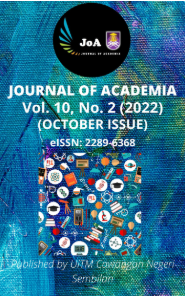ISOLATION OF B. cereus s.l. FROM DRIED HERBS AND SPICES PRODUCTS AND MILK PRODUCTS PURCHASED FROM LOCAL MARKETS IN NEGERI SEMBILAN
Keywords:
16S rRNA sequencing, Bacillus cereus, food poisoning, isolation, Mannitol Egg-Yolk Polymyxin agarAbstract
Bacillus cereus is a spore-forming bacterium that is widely distributed in the environment and can be
detected in a variety of food including dried herbs and spices and milk products. When the vegetative
form of the bacteria produces toxins, these can result in food borne illness and pose a significant public
health hazard. However, no or less study in food health safety related to B. cereus has been done in
Malaysia. This study aims to isolate B. cereus in dried herbs and spices and milk products using
selective and differential Mannitol Egg-Yolk Polymyxin (MYP) agar and Gram staining. The
presumptive colonies of B. cereus were selected based on mannitol and lecithinase utilization on MYP
agar and showed Gram-positive rod-shaped bacteria by Gram staining. These presumptive B. cereus
were then confirmed using 16S rRNA sequencing. For the dried herbs and spices, four out of ten
samples were presumptive B. cereus, however only three were confirmed and identified as B. cereus
s.l. From these three samples with positive B. cereus s.l., two samples were contained more than 104
CFU/g indicating the samples contain a high number of colonies that may result in food poisoning.
Meanwhile, for the milk products, out of 12 samples, three samples showed presumptive B. cereus on
MYP plates, however identified as non B.cereus using 16S rRNA sequencing. Thus, further isolation
and identification of the isolated bacteria in a larger sample need to be carried out to provide the data
prevalence of B. cereus in Malaysian dried products and milk products and to serve as extra information
about the safety of consuming dried items that may cause harm to people.
References
Berthold-Pluta, A., Pluta, A., Garbowska, M., & Stefańska, I. (2019). Prevalence and toxicity characterization
of Bacillus cereus in food products from Poland. Foods ,8(7), 269.
Beveridge, T.J. (1990). Mechanism of Gram variability in select bacteria. Journal of Bacteriology, 172(3), 1609-
Cardazzo, B., Negrisolo, E., Carraro, L., Alberghini, L., Patarnello, T. & Giaccone, V. (2008) Multiple-locus
sequence typing and analysis of toxin genes in Bacillus cereus food-borne isolates. Applied and Environmental
Microbiology, 74(3), 850-60.
Chon, J.W., Hyeon, J.Y., Park, J.H., Song, K.W., Kim, J.H. & Seo, K.H. (2012). Improvement of Mannitol-Yolk
Polymyxin B agar by supplementing with trimethoprim for quantitative detection of Bacillus cereus in food.
Journal of Food Supply, 75(7), 1342-1345.
Fogele, B., Granta, R., Valciņa, O., Bērziņš, A. (2018). Occurrence and diversity of Bacillus cereus and moulds
in spices and herbs. Food Control, 83, 69-74.
Food Standards Australia New Zealand [FSANZ] (2001). Guidelines for Microbiological Examination of Ready
to-Eat Foods.
Gdoura-Ben Amor, M., Siala, M., Zayani, M., Grosset, N., Smaoui, S., Messadi-Akrout, F., Baron, F., Jan, S.,
Gautier, M., & Gdoura, R. (2018). Isolation, identification, prevalence, and genetic diversity of Bacillus
cereus group bacteria from different foodstuffs in Tunisia. Frontiers in Microbiology, 9, 447.
ISO International Standardisation Organisation. Microbiology of food and animal feeding stuffs – Horizontal
method for the enumeration of presumptive Bacillus cereus – Colony-count technique at 30C. EN ISO
:2004.
Liu, Y., Lai, Q., Göker, M., Meier-Kolthoff, J.P., Wang, M., Sun, Y., Wang, L. & Shao, Z.(2015). Genomic
insights into the taxonomic status of the Bacillus cereus group. Science Reports, 5, 14082.
Martinez-Porchas, M., Villalpando-Canchola, E., Ortiz Suarez, L. E., & Vargas-Albores, F. (2017). How
conserved are the conserved 16S-rRNA regions?. PeerJ, 5, e3036.
Mihat, O. (2017). Waterborne Food Poisoning Outbreak of Bacillus cereus in Primary School Sabah. Advanced
Research Publications, 3(January), 22–29.
Noguera, P. A., & Ibarra, J. E. (2010). Detection of new cry genes of Bacillus thuringiensis by use of a novel PCR
primer system. Applied and Environmental Microbiology, 76(18), 6150–6155.
Peterz, M., Wiberg, C., & Norberg, P. (1985). Comparison of media for isolation of Bacillus cereus from foods.
Journal of Food Protection, 48(11), 969-970.
Rampal, L., Jegathesan, M., and Lim, Y. S. (1984). An outbreak of Bacillus cereus food poisoning in a school
hostel, Klang. Medical Journal of Malaysia, 39(2), 116–122.
Sajali, N., Wong, S. C., Hanapi, U. K., Abu Bakar @ Jamaluddin, S., Tasrip, N. A., & Mohd Desa, M. N. (2018).
The challenges of DNA extraction in different assorted food matrices: A review. Journal of Food Science, 83(10),
–2414.
Schoeni, J.L. & Wong, A.C.L. (2005). Bacillus cereus food poisoning and its toxin. Journal of Food Protection
(3), 636-648.
Talahmeh, N., Abu-Rumeileh, S., & Al-Razem, F. (2019). Development of a selective and differential media for
the isolation and enumeration of Bacillus cereus from food samples. Journal of Applied Microbiology, 128(5),
-1447.
Tallent, S.M., Kotewicz, K.M., Strain, E.A., & Bennet, R.W. (2012). Efficient isolation and identification of
Bacillus cereus group. Journal of AOAC International, 95(2), 446-451.
Ubong, A., New, C. Y., Chai, L. C., Loo, Y. Y., Nor Khaizura, M.A.R., Kayali, A. Y. and Son,
R. (2020). Prevalence of Bacillus cereus s.l. in ultra-high temperature chocolate milk from selected milk
manufacturers in Malaysia. Food Research, 4(4), 982-990.
Downloads
Published
Issue
Section
License
Copyright (c) 2022 Journal of Academia

This work is licensed under a Creative Commons Attribution-NonCommercial-NoDerivatives 4.0 International License.












